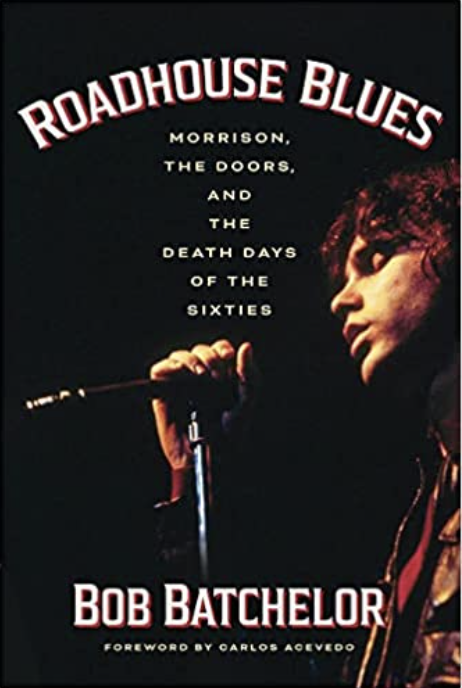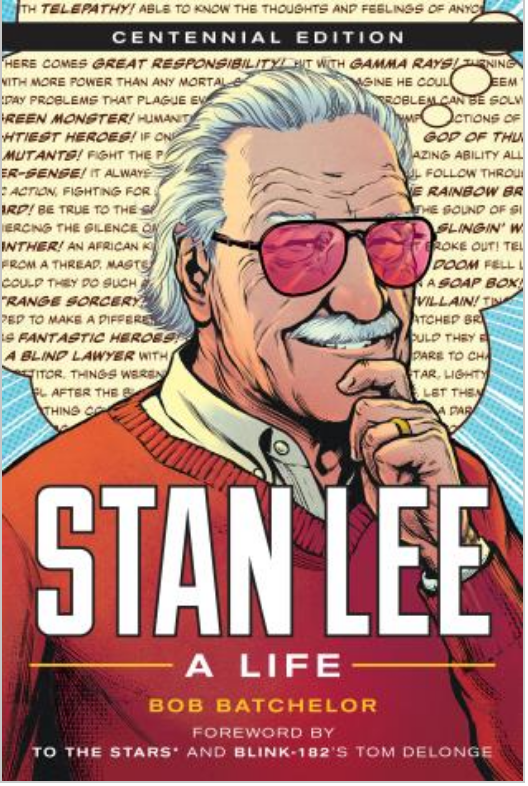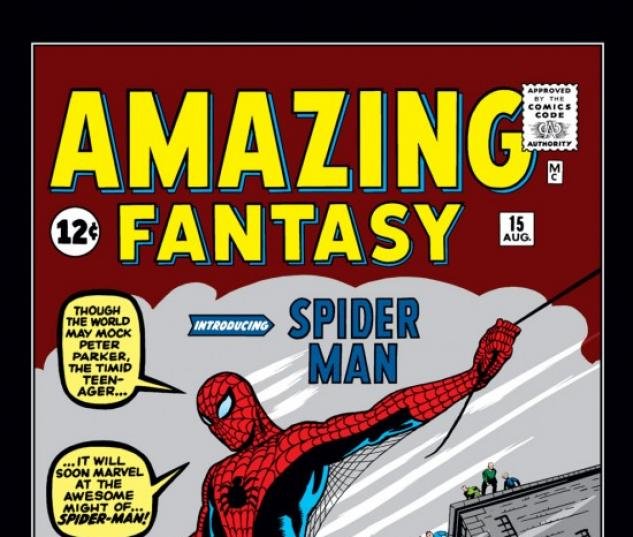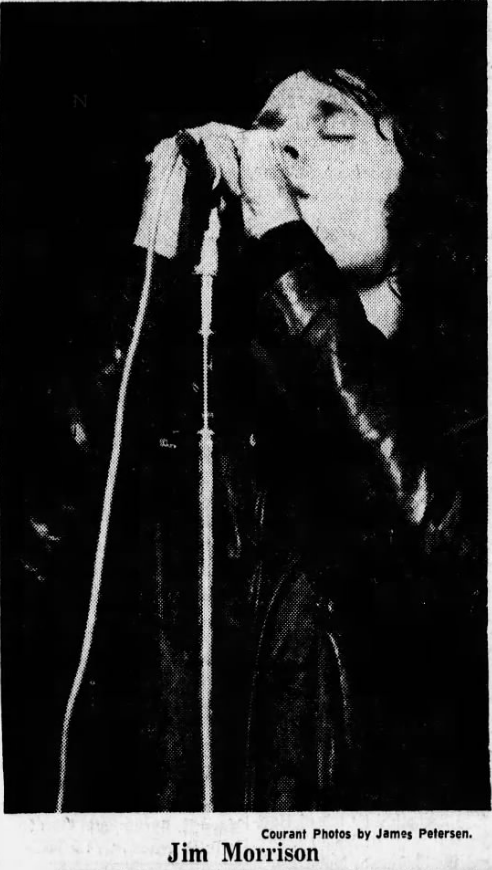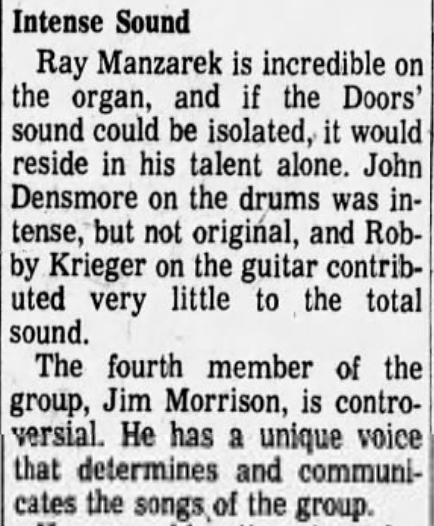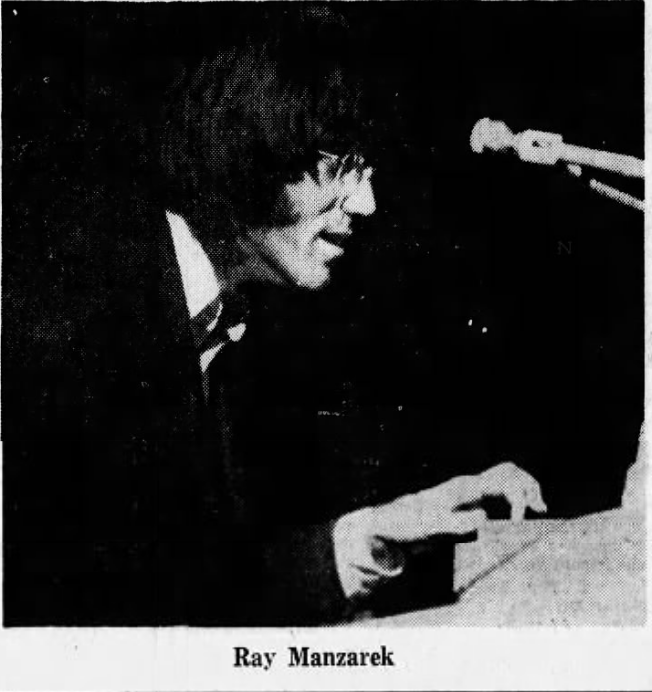Filled with mayhem, mountains of illicit cash, and rivers of bourbon, “Tales of the Bourbon King” presents the life and crimes of George Remus, bootleg king of the Jazz Age, a dazzling true crime spectacle. With gunfights and fisticuffs, he turned America into his violent playground, grafting his way into Warren Harding’s White House. A model for Jay Gatsby, Remus’s story epitomizes the spectacular 1920s – until it came crashing down in an improbable tale of deceit and rage, centered on the dastardly G-man who stole his wife, leading directly to a fateful gunshot that ended her life.
Read moreROADHOUSE BLUES NAMED 2023 INDEPENDENT PRESS AWARD BEST MUSIC BOOK
Cultural Historian Bob Batchelor Wins Independent Press Award® for Roadhouse Blues, Rollicking Tale of 1960s and 1970s America; Published by Hamilcar Publications
BOSTON & RALEIGH, March 20, 2023 – Shrouded in mystery and the swirling psychedelic sounds of the Sixties, the Doors have captivated listeners across seven decades. Jim Morrison—haunted, beautiful, and ultimately doomed—transformed from rock god to American icon. Yet the band’s full importance is buried beneath layers of mythology and folklore.
Cultural historian and biographer Bob Batchelor looks at the band and its significance in American history in Roadhouse Blues: Morrison, the Doors, and the Death Days of the Sixties (Hamilcar Publications).
Roadhouse Blues Wins 2023 IPA Book Award in Music
In recognition of the book’s excellence in writing, cover design, editorial production, and content, the Independent Press Award recognized Roadhouse Blues as the 2023 book award winner in the Music category. Selected IPA Award Winners are based on overall excellence among the tens of thousands of independent publishers worldwide. Roadhouse Blues is the third award Batchelor has earned from IPA.
“Roadhouse Blues is candid, authoritative, and a wonderful example of Batchelor’s absorbing writing style,” said Kyle Sarofeen, Founder and Publisher, Hamilcar Publications. “Taking readers beyond the mythology, hype, and mystique around Morrison, the book examines the significance of the band during a pivotal era in American history. Readers and reviewers have proclaimed that Roadhouse Blues is the most important book about the Doors ever written, just behind the memoirs of Ray Manzarek, John Densmore, and Robby Krieger.”
Cultural Historian Bob Batchelor Wins 2023 Independent Press Award — #GabbyBookAwards
“Independent publishing is pushing on every corner of the earth with great content,” said Gabrielle Olczak, Independent Press Award sponsor. “We are thrilled to be highlighting key titles representing global independent publishing.”
REVIEWS OF ROADHOUSE BLUES
“Fascinating, informative, extraordinary, and essential reading for the legions of Jim Morrison fans.” – Midwest Book Review
“Bob Batchelor writes with great eloquence and insight about the Doors, the greatest hard-rock band we have ever had, and through this book, we plunge deeply into the mystery that surrounds Jim Morrison. It is Batchelor’s warmth and compassion that ignites Roadhouse Blues and helps explain Morrison’s own miraculous dark fire.” – Jerome Charyn, PEN/Faulkner award finalist
“The most important book for Doors fandom since No One Here Gets Out Alive—and incomparably better! Grouped with Ray, Robby, and John’s books, this is the fourth gospel for fans of The Doors.” – Bradley Netherton, The Doors World Series of Trivia Champion and host of the podcast “Opening The Doors”
For more information, please visit independentpressaward.com. To see the list of IPA Winners, please visit: https://www.independentpressaward.com/2023winners
An excerpt “My Doors Memoir” is available at
https://hannibalboxing.com/excerpt-roadhouse-blues-morrison-the-doors-and-the-death-days-of-the-sixties/ (Open Access)
Hamilcar Publications
https://hamilcarpubs.com
Foreword by Carlos Acevedo
ISBN 9781949590548, paperback
ISBN 9781949590548, eBook
ABOUT BOB BATCHELOR
Bob Batchelor is the author of Roadhouse Blues: Morrison, the Doors, and the Death Days of the Sixties and Stan Lee: A Life. He has published widely on American cultural history, including books on Bob Dylan, The Great Gatsby, Mad Men, and John Updike. Rookwood: The Rediscovery and Revival of an American Icon, An Illustrated History won the 2021 IPA Award for Fine Art. The Bourbon King: The Life and Crimes of George Remus, Prohibition’s Evil Genius won the 2020 IPA Book Award for Historical Biography. Stan Lee: The Man Behind Marvel was a finalist for the 2018 Ohioana Book Award for Nonfiction.
Batchelor’s work has been translated into a dozen languages and appeared in Time, the New York Times, Cincinnati Enquirer, American Heritage, The Guardian, and PopMatters. He hosts “Deep Cuts” on the New Books Network podcast and is creator/host of the John Updike: American Writer, American Life podcast. He has appeared as an on-air commentator for National Geographic Channel, PBS NewsHour, BBC, PBS, and NPR. Batchelor earned a doctorate in Literature from the University of South Florida. He and his wife Suzette live in North Carolina with two wonderful teenage daughters. Visit him at www.bobbatchelor.com or on Facebook, LinkedIn, or Instagram.
Contact:
Kyle Sarofeen, Publisher, Hamilcar Publications
kyle@hamilcarpubs.com
OR
Bob Batchelor, bob@bobbatchelor.com
###
The Doors Explode into New York City -- March 1967
West Meets East When Doors Play Big Apple Shows, March 1967
New York City loved the Doors!
A handbill for the Doors concerts at Ondine!
After two early trips East to play New York City’s famous Ondine nightclub — well before they were famous — the Doors returned in March 1967 to a series of shows running through early April that would establish them as a favorite of fans and critics. The spark they received was a launchpad, especially in the dark days after “Break On Through” had been released (and fizzled on the pop charts) and prior to the national sensation that became “Light My Fire.”
On the third trip to NYC, the Doors intensified their mysticism and mystery for the celebrities and fame junkies that assembled at Ondine. While they had mainly been an underground hit on the two previous residencies, this time the press showed up too, eager to find out more about the psychedelic sounds emanating from Los Angeles and the beautiful singer who fronted the darkness.
Jim Morrison played up the differences between the coasts, which magnified his aura. As always, he spoke in proto-hippie lingo, but under a layer of foreboding. His words were sensuous and of the earth — heat, dirt, its elemental foundations.
“We are from the West. The world we suggest should be of a new Wild West. A sensuous, evil world. Strange and haunting…the path of the sun, you know.” — Jim Morrison
THE ONDINE AND NEW YORK HIPSTERS
The Ondine was a tiny club in Manhattan on Fifty-Ninth Street where celebrities and the city’s elite went to let loose. The hippest person on the scene was Andy Warhol, accompanied by his many acolytes and hangers-on — the beautiful people — but others included Jackie Kennedy, Jackie Gleason, and a horde of models, actors, and glam devotees.
The Ondine basically operated as a private discotheque long before disco would become all the rage. The raw environment brought together the rich, the wannabees, and others in a kind of fashionable speakeasy featuring go-go dancers, frenzied dance music, and an outrageous cast of characters. The basement locale was an odd place for ritzy socialites, basically tucked under a bridge in an ominous part of the city just three blocks from the East River. Similar to London Fog (where the Doors played in LA and created their famous sound), the club, named after the famous racing yacht Ondine, had a cramped stage that contrasted with its nautical theme.
The location of the Ondine nightclub today via Google Maps (March 2023)
Club manager Brad Pierce had been instrumental in getting the Doors booked for those early shows. Warhol later claimed that the band had gotten its break because a female deejay who had moved from LA knew the guys and urged Pierce to bring them east. To New York audiences, the Doors were billed as the hottest underground band in the nation and the LA connection helped establish that credibility. Enough people were bicoastal and had heard whispers about the group.
Everyone wanted to see the lead singer.
Of course, Jim met Warhol at the first run of shows. The iconic artist was reportedly so nervous about the encounter that he spent an evening mumbling to himself and awkwardly avoiding the singer. Eventually Warhol overcame his stage fright, probably at the sight of so many women mobbing Morrison while he stood at the bar between sets. “It was love at first sight on Andy’s part,” Ray said later.
BREAK ON THROUGH
Journalist Richard Goldsten took notice of the Doors and urged listeners to give the debut album a spin.
“Their initial album, on Elektra, is a cogent, tense, and powerful excursion. I suggest you buy it, slip it on your phonograph, and travel on the vehicle of your choice,” he explained. “The Doors are slickly, smoothly, dissonant. With the schism between folk and rock long since healed, they can leap from pop to poetry without violating some mysterious sense of form.”
From Goldstein’s perspective, the reason for the band’s success was its foundation in the blues. “This freedom to stretch and shatter boundaries make pretension as much a part of the new scene as mediocrity was the scourge of the old,” Goldstein wrote. “It takes a special kind of genius to bridge gaps in form. Their music works because its blues roots are always visible. The Doors are never far from the musical humus of America — rural, gut simplicity.”
What few could have imagined was that the Doors were on the verge of superstardom!
The band had seized the rippling current running through the Sixties, sucking in the joy and the darkness and spitting it out at audiences in a way that left listeners jubilant with the promise of good and bad, light and evil. The shows at the Ondine would be the last stretch before “Light My Fire” changed the band forever.
If the music pushed you hypnotically toward the edge of a cliff, Morrison stood ready to push. But you also felt that he was ready to jump too, plunging into worlds and universes unknown.
Roadhouse Blues: Morrison, the Doors, and the Death Days of the Sixties by cultural historian and biographer Bob Batchelor
The Doors Invade San Francisco: The Human "Be-In" Kicks Off the Summer of Love
Part of the education of The Doors in the City by the Bay took place at The Human Be-In, a festival featuring music, activists, and spirituality in Golden Gate Park. Twenty thousand or more people had gathered to protest a California law banning LSD that had passed the previous fall. The Doors played elsewhere throughout the weekend but weren’t established enough to play the festival. The experienced the hippie vibe, firsthand, though as part of the throngs of people that descended on San Francisco, ultimately launching the “Summer of Love.”
Read moreHappy 100th Birthday Celebration for Marvel Legend Stan Lee
Stan Lee as Artist and Producer — The Man “Behind” Marvel’s Success
Stan Lee: A Life by cultural historian Bob Batchelor
Stan Lee had been working in the comic book industry for decades before the successes of the 1960s. Lee’s most important lessons from those first two-plus decades in comic book publishing were about how to manage a business, the seemingly simple on paper, but difficult in practice nature of running a company.
Comic book publishing was not for the meek – governed by relentless deadlines in an era before technology made many of the processes more efficient. While not trained in business, Lee became a manager, which gave him insider perspective into the machinations of the industry, particularly in contrast to the artist or writer view that is solely on their specific creation. From an enterprise perspective, Lee learned everything that would enable him to re-launch Marvel in the early 1960s, ultimately overseeing the company as it became a force in comic books and later, American popular culture as a whole.
Yet, if we were just discussing Lee as an editor and manager of Marvel, the story would be truncated. Of course, he was also a creator, as were so many of the early comic book artists and writers, more or less forced into developing managerial acumen, because, well someone had to run the business side. What emerged in Lee as a result of the melding of the business and creative parts of his work life was a keen sense of responsibility. He had to nurture the artistic aspects of comic book creation, from writing and editing to assigning cover art and lettering, while also overseeing the business side, from managing budgets to working with the production team to ensure deadlines were met in an industry with slim margin for error. Ultimately, all responsibility wrapped back to Lee.
Rather than these viewpoints warring inside Lee as he built his career, he used them as a way to create a central worldview: Comic books were important as tools to educate. They had value for readers – regardless of age – as a means of education, including outlining a value system based on the complexity of the human experience, not unlike literature and poetry. Lee realized that this perspective stood in contrast to the mainstream opinion that comic books were “pulp,” simple stories aimed at children and feeble-minded adults (a common belief through the 1960s).
Without going into deep analysis of the controversial creation of Spider-man – an amalgamation of the thinking and experiences lived by Lee, Steve Ditko, Jack Kirby – the character’s popularity provided Lee with an instrument to explore his ideas about how important comic books could be as tool for education. Spider-man gave him influence and proved that he could help shape culture in ways unimaginable during the first 20 years of his career.
Continually attempting to establish Marvel as different, Lee started calling the company the “House of Ideas,” which stuck with journalists and became part of the company’s cachet. If a downside existed in the surge of Marvel comics into the public consciousness it is that Lee and his bullpen teammates had to balance between entertainment, social issues, and profitability. Stan valued the joy derived from reading comics, but he wanted them to be useful: “Hopefully I can make them enjoyable and also beneficial…This is a difficult trick, but I try within the limits of my own talent.” Lee wanted to have it both ways – for people to read the books as entertainment, but also be taken seriously.
“Hopefully I can make them enjoyable and also beneficial…This is a difficult trick, but I try within the limits of my own talent.”
At the same time, Marvel had to sell comics, which meant that little kids and young teenagers drove a sizeable chunk of the market. In 1970, Lee estimated that 60 percent of Marvel’s readers were under 16-years old. The remaining adult readership was enormous given historical numbers, but kept Lee focused on the larger demographic. “We’re still a business,” he told an interviewer. “It doesn’t do us any good to put out stuff we like if the books don’t sell…I would gain nothing by not doing things to reach the kids, because I would lose my job and we’d go out of business.”
On one hand, the industry moved so quickly that Lee and his creative teams constantly fought to get issues out on time. The number of titles Marvel put out meant that everyone had to be constantly producing. So, when Lee was in the office or working from home, he committed to getting content out. Roy Thomas recalls, “Stan and I were editing everything, and the writers were editing what they did, and we had a few assistant editors that didn't really have any authority...that was about it.” However, that chaotic atmosphere made it rife for animosities to form or fester. Lee needed content out the door and Goodman tried to maintain control over cover artwork and other little details that inevitably slowed down the process.
Thomas’ ascension and Lee’s pull toward management did shift the editorial direction, if for no other reason than that Stan wouldn’t be writing full-time any longer. “It was time to kind of branch out a little bit,” Thomas explained. “We wanted to keep some of that Marvel magic, and at the same time, there had to be room for other art styles and other writing styles.” The most overt change came when Lee turned in the copy for The Amazing Spider-Man #110. The late 1971 issue was the last Lee wrote for the character. Writer Gerry Conway succeeded Lee and the next books in the series would be co-created by Conway and star artist John Romita.
While many adults looked down on Lee for writing comic books, especially early in his career, he developed a masterful style that rivals or mirrors those of contemporary novelists. Lee explained:
Every character I write is really me, in some way or other. Even the villains. Now I’m not implying that I’m in any way a villainous person. Oh, perish forbid! But how can anyone write a believable villain without thinking, “How would I act if he (or she) were me? What would I do if I were trying to conquer the world, or jaywalk across the street?...What would I say if I were the one threatening Spider-Man? See what I mean? No other way to do it.”
Lee’s distinctive voice captured the essence of his chosen medium.
Lee also understood that the meaning of success in contemporary pop culture necessitated that he embrace the burgeoning celebrity culture. If a generation of teen and college-aged readers hoped to shape him into their leader, Lee would gladly accept the mantle, becoming their gonzo king. Fashioning this image in a lecture circuit that took him around the nation, as well as within the pages of Marvel’s books, Lee created a persona larger than his publisher or employer. As a result, he transformed the comic book industry.
Unlike Bob Dylan or Jann Wenner, for example, Stan didn’t plan this revolution. He didn’t say to himself that he would cocreate a character that would become part of American folklore. It wasn’t planned, yet it seems completely intentional.
Baby boomers grew up with Stan’s voice in their heads. Interestingly, Lee spoke for Marvel’s superheroes to eager audiences talking about the characters, while at the same time creating the dialogue in the actual comics. So he was the person talking about the characters he himself was voicing. In addition, he wasn’t just in the media; Stan was talking directly to readers within the pages. He was Spider-Man’s voice, while also talking about the comics, the company, his colleagues, and the world to a captivated audience.
By the time Gen Xers started reading comics, Marvel’s style was wholly entrenched. As each generation ages out of traditional comic book reading age, Lee’s voice becomes commensurate with nostalgia—a part of our lives we look back to with fondness and equate with better times. Immersed in a heavily capitalistic, entertainment-driven culture, embedded stories are ones that get retold, and Marvel superheroes become a balm for a cultural explosion driven by cable television, global box office calculations, and the web. In what seems like the blink of an eye, the Marvel voice became the voice of modern storytelling.
Why did the Marvel Universe come to dominate global popular culture? Largely based on Stan supplying a voice to a mythology. Certainly, the creation of the Marvel Universe was a team effort, like all forms of entertainment, nothing is created in a vacuum. There are unheralded people in the process and those who deserve as much credit as Lee for their roles. Yet, it was the unmistakable “music” that Lee conceived that launched a cultural revolution.
Crisscrossing the nation while speaking at college campuses, sitting for interviews, and conversing with readers in the “Stan’s Soapbox” pages in the back of comic books, Lee paved the way for intense fandom. His work gave readers a way to engage with Marvel and rejoice in the joyful act of being a fan. Geek/nerd culture began with “Smiley” and his Merry Marauding Bullpen nodding and winking at fans each issue. Lee’s commitment to building a fan base took fandom beyond sales figures and consumerism to authentically creating communities. The Marvel Cinematic Universe has spun this idea into global proportions. It is the fans of the MCU across film and television that has reinforced and spread Stan’s voice across the world.
Amazing Fantasy #15, the comic that launched Spider-Man into the popular culture stratosphere
The superheroes that Lee and his co-creators brought to life in Marvel comic books remain at the heart of contemporary storytelling. Lee created a narrative foundation that has fueled pop culture across all media for nearly six decades.
By establishing the voice of Marvel superheroes and shepherding the comic books to life as the creative head of Marvel, Lee cemented his place in American history. According to analyst Paul Dergarabedian, the results have been breathtaking: “The profound impact of Stan Lee’s creations and the influence that his singular vision has had on our culture and the world of cinema is almost immeasurable and virtually unparalleled by any other modern day artist.”
“The profound impact of Stan Lee’s creations and the influence that his singular vision has had on our culture and the world of cinema is almost immeasurable and virtually unparalleled by any other modern day artist.”
Morrison Arrested Onstage in New Haven -- Beginning of the End
Jim Morrison’s arrest in December 1967 while on stage at the New Haven Arena is important in understanding the Sixties. The incident represents how myriad people and institutions in a position of power were willing to use their authority to stamp out or thwart those who symbolized something they didn’t understand or even attempt to comprehend. For those wielding a hammer, as is said, everything looks like a nail. The establishment’s reaction to Morrison and the Doors was to look at them as something evil that had to be stopped.
Read moreHappy Birthday Jim Morrison -- The Legendary Dark Knight of American Rock Music History
The “real” Jim Morrison comes to life in Roadhouse Blues: Morrison, the Doors, and the Death Days of the Sixties by award-winning cultural historian Bob Batchelor. December 8 is Jim Morrison’s birthday. He would have been 79 years old. His death at 27 is part of rock music folklore and pop culture history, but what a tragedy.
Read moreDOORS CONCERT REVIEW -- 55 YEARS AGO!
“Primitive, Grotesque, and Blatantly Sexual”
Jim Morrison, lead singer of the Doors, Hartford, December 2, 1967
Hartford Courant reporter James Petersen was not a fan of The Doors. In his review, published 55 years ago on December 2, 1967, he centered on then-accepted notion that anything from California was odd and drug-addled. “Beautiful, beautiful” is most certainly a drug reference, his indication of how a high Californian would react to the spectacle of the band and its leather-clad singer.
Harsh criticism of the Doors concert
Rather than declare the Doors bad, Petersen puts his opinion in the mouth of an older “ticket seller,” who he believes would see the band, audience, and performance as “primitive, grotesque, and blatantly sexual.” What the reporter wants the reader in conservative Hartford, Connecticut, to understand is that the Doors and Jim Morrison are dangerous. The coded language is the type the band often faced when looked at by those who represented the establishment or “traditional” values.
In other words, devalue the band and its members as both musicians and people: fear the grotesque and outlaw the sexual.
The drumbeat against the Doors and Morrison picked up pace in late 1969, especially after Morrison was arrested on stage in New Haven just one week later. The entire nation — and the federal government — would turn against the Doors, a slippery slope that would be the catalyst for Morrison’s untimely death just three and a half years later.
The reporter is obviously an organ fan…he loves Ray’s organ!
Surprisingly, the only member of the Doors that the reporter enjoyed was Ray Manzarek’s organ. The irony here is that Ray’s driving sound, ranging from dark and eerie to carnival-like and filled with joy, was the sound of the band. How could they be primitive if he liked their essential sound?
Ray Manzarek — “Keyboardist” of the Doors and mastermind of their unique sound!
When Petersen did opine on where he ranked the Doors versus other bands, he ranked them lower than both Procol Harum and the Paul Butterfield Blues Band.
Read the story of the Doors and the Death Days of the Sixties in Roadhouse Blues, published by Hamilcar Publications! For the holidays, the book has been discounted to $15 when ordered at: https://indiepubs.com/products/roadhouse-blues/
JIM MORRISON ARRESTED -- AGAIN
With Miami Indecency Trial Looming, Jim Morrison Arrested on Flight and Faces Federal Charges
Jim Morrison couldn't stay out of trouble, especially when actor Tom Baker was instigating. They got really drunk and rowdy on a flight to Phoenix to see the Rolling Stones, but instead, got arrested and in serious jeopardy when charged with felony offenses.
Jim Morrison -- Arrested Again
Between March 5, 1969, when acting Miami police chief Paul Denham took warrants out on Jim, and the start of the trial on August 10, 1970, the federal government, the state of California, and the state of Florida tried several legal maneuvers to get the Doors front man to submit. At the same time, Jim’s attorney, Max Fink, fought these efforts, including filing several motions to dismiss the case.
"Too High in Sky" -- Jim Morrison Arrested & Jailed in Phoenix
While the wrangling sped along, Morrison’s personal life continued to unravel. He was arrested twice more in that seventeen-month span, first in November for causing a disturbance on a flight and then later the next August for public drunkenness in West Hollywood (when a sixty-eight-year-old woman found him sleeping on her porch and called police). According to Ray Manzarek, "Between Miami and Phoenix, Jim was facing a maximum of over thirteen years in prison."
"Between Miami and Phoenix, Jim was facing a maximum of over thirteen years in prison."
— Ray Manzarek
For more great stories, interesting analysis, and an in-depth look at the Doors and Jim Morrison, check out Roadhouse Blues: Morrison, the Doors, and the Death Days of the Sixties (Hamilcar Publications)
Roadhouse Blues by Cultural Historian Bob Batchelor
The Sound of the Sixties -- The Doors "Electric Eclectic"
What fans around the world were hearing, according to Ray Manzarek, was “electric eclectic,” a mix of jazz, blues, and hard rock — all infused with a mix of American grit and psychedelic vibes that the band brought to life. That combination came from the gifts of each band member, from Ray’s intensity and grace, Robby’s charging guitar, John’s jazzy beat and musical spirit, and Jim’s “literary side.”
Read more

